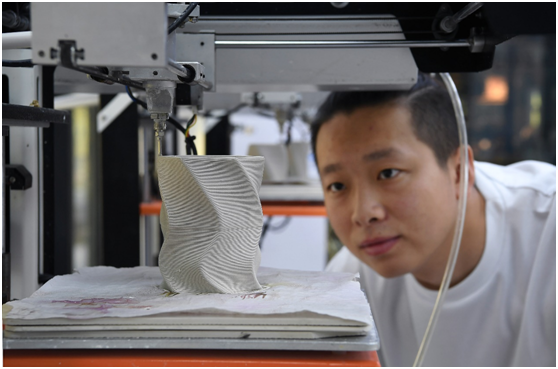
Making a porcelain vase with 3D printingtechnology at the Experience Centerfor 3D Printing Ceramics in TaoxichuanCeramic Art Avenue, Jingdezhen, Jul.26, 2019. (Xinhua)
"It takes 72 processes to make a porcelain cup." This mirrors the complexity of the traditional manual porcelain making process in T'ien-kung K'ai-wu(exploitation of the works of nature), written by Song Yingxing, a scientist of the Ming Dynasty. The rapid development of modern science and technology has brought greater magic power to the porcelain production today.
Walking into the Smart Workshop of Jingdezhen's Yishan Ceramics Co., Ltd. (JYC), you can only hear the machines roaring, but see no workers. On an automatic isostatic pressing production line, powdery raw materials originally packed in bags immediately turn into white disks. Then, the manipulator quickly "decorates" these disks, and completes the processes of trimming, water replenishment and molding.
"Intelligence has greatly improved the production efficiency of enterprises," said Yin Zhongwei, deputy general manager of JYC. "Taking the isostatic pressing automatic production equipment. One equipment can produce up to 500 molded products in one hour."
Such large-scale intelligent manufacturing has enabled enterprises to obtain huge effective capacity. According to Yin, enterprises are therefore confident enough to take large orders. At the beginning of its inception, JYC aimed to build an industrial 4.0 intelligent factory. Now, it has introduced more than 20 sets of intelligent manufacturing equipment, achieving an annual output of 10 million pieces.
The magic of science and technology is reflected not only in the rapid quantitative change from 1 to 100, but also in the breakthrough qualitative change from 0 to 1.
"It has been one of the headaches of the ceramic industry that design can't be turned into reality. Nowadays, we have adopted computer modeling, 3D printing and other technologies to address this problem," said Xing Hao, director of the Strategic Development Department of Jingdezhen Ceramics Group Co., Ltd. (JCG).
At the Design Center of JCG, designers are busy designing, drawing and proofing in front of computers. Not long ago, Hu Cong, a designer, received a design drawing of a wine glass. Seeing the complex parameters on it, he immediately realized that it was a hard nut.
"The customer expressed very precise requirements for the radian at the cup mouth, cup body, among others, and wanted us to make it by hand. But after evaluation by the craftsman, we found that it was a ‘mission impossible’," Hu recalled.
It was "impossible" by hand, but "possible" with the "magic machine". According to the drawings, Hu quickly made a mold with 3D modeling programs, numerical control engraving machines and other equipment, and delivered it to the workshop to produce a ceramic sample, which was eventually accepted by the customer with its excellent quality.
To pursue further development, the ceramic industry needs to produce quality and distinctive products, which cannot be achieved without science and technology. Some insiders pointed out that Jingdezhen's ceramic industry declined in the 1990s, largely because of its outdated design and technology.
Today, however, driven by scientific and technological innovation, a multitude of practices integrating digital technology with the ceramic industry have sprung up in succession and promoted Jingdezhen to become a vital model for the digital transformation of the ceramic industry in China.
JYC makes its Design and R&D Center available to and shared by over 140 small and micro-enterprises in the park, while JCG joins hands with local ceramic enterprises to build a super digital supply chain... The position of enterprises as the main body of innovation has been enhanced continuously.
The collaborative innovation mechanism of "industry, university, research, user, finance and intermediary" has also been improved constantly. Not long ago, Jingdezhen Ceramic Institute and Jiangxi Ruicai Ceramic Raw Materials Co., Ltd. jointly launched the scientific achievement of "Producing High Temperature Daily Fine Porcelain Ware with Ehu Muscovite Granite Porphyry as Raw Materials", which passed the appraisal of the China National Light Industry Council.
It is learned that a new type of raw material, muscovite granite porphyry ceramic, has been found to replace 100 percent of the traditional porcelain stone, thus addressing the problem of depletion of ceramic raw material resources in Jingdezhen.
At the School of Digital Arts under Jiangxi Arts & Ceramics Technology Institute, teachers and students have changed ceramic design methods through digital technology, adopted digital innovative means to design gift porcelain, craft porcelain and daily porcelain, and actively promoted the application of digital technology, digital platform and VR virtual production platform in ceramic designing.
"I hope that smart printers will print ceramic products with one click in the future, and we can get whatever we want," Hu imagined.
"I hope Jingdezhen can become the aircraft carrier of the ceramic industry in the country," Xing aspired.
Jingdezhen, with its ceramics, will amaze the world again. This is the vision of generations of ceramics makers here, and it has become an inexhaustible driving force for many to pursue perfection unwaveringly.
Here in Jingdezhen, an ancient yet young city, everyone has a "ceramic dream". The power of science and technology has made every dream realizable and become a golden key to unveiling a new chapter of "clay and fire".

Photo shows a work with the font matrices of Chinese surnames made with 3D ceramic printing technology, Oct. 16, 2019. (Xinhua)




 A single purchase
A single purchase









